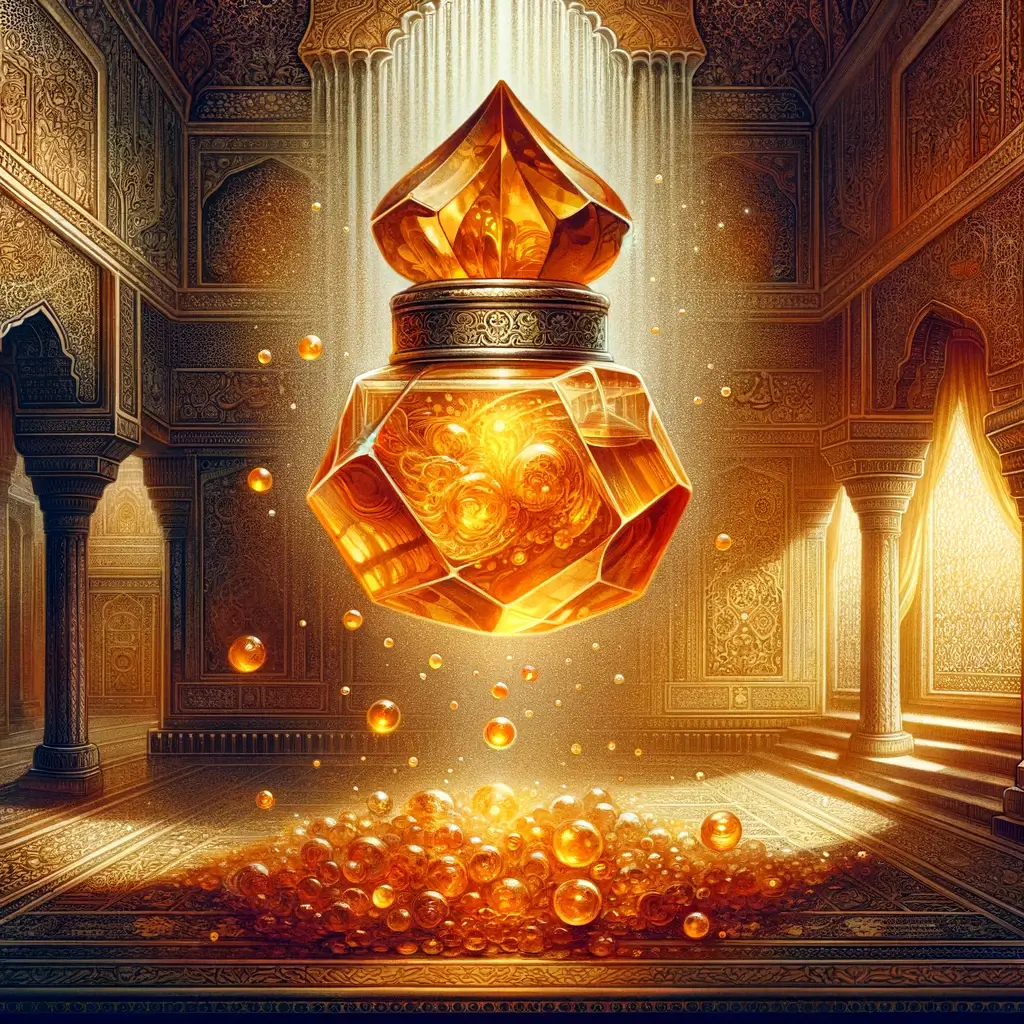Amber is a warm, radiant orange-yellow color that has an inviting, cozy tone. It gets its name from the fossilized tree (Petrified wood) resin that ranges in color from pale yellow to orange, which people have valued for centuries in jewelry and decoration.
Unlike many colors, amber’s name describes the actual hue quite well. When most people think of the color amber, they imagine a translucent golden-orange shade with just a hint of reddishness. The name comes from the Arabic word anbar, which refers to ambergris – a waxy substance from sperm whales used in perfume. This reflects the color’s antiquity and cross-cultural appeal.
As a pure chromatic color that contains no black or white, amber is seen as youthful and energetic. Yet its mellowness gives it a sentimental, nostalgic feeling as well. The color captures the essence of fall leaves, candlelight, honey, and autumn harvest. For many, amber evokes fond memories of childhood joy, family gatherings, and happy days gone by. Its radiance also suggests ideas like wisdom, knowledge, and creativity.
👉🏾 Other Swiftspeed Users also read: How to make money from apps Using Fremium app monetization
Amber sits between yellow and orange on the color wheel. It combines the friendly, sunny feeling of yellow with the boldness and energy of orange. The result is a vibrant color that conveys warmth, nostalgia, and approachability. Amber is often described as cozy, inviting, comforting, and cheerful. Its warm tone seems to radiate positivity and optimism.

Properties of Amber
Amber is a fossilized tree resin. It has been appreciated for its color and natural beauty since Neolithic times. The properties of amber result from its biological origin.
Physically, amber is lightweight, with a relative density of 1.05 to 1.10. Natural amber floats on salt water. The hardness of amber ranges between 2 and 3 on the Mohs hardness scale. Amber is brittle and fractures conchoidally, with the shards having very sharp edges.
The chemical composition of amber is complex because the resin goes through polymerization and oxidation during the fossilization process over millions of years. The main component of amber is terpenes, which give it its pine tree scent when burned. Amber also contains succinic acid, palmitic acid, stearic acid, and other organic acids. It can contain up to 8% sulfur. Trace amounts of iridium in Baltic amber indicate connections to the KT extinction event.
Amber is thermoplastic, meaning it softens with heat. It melts at temperatures between 200°C and 400°C, depending on its composition. When melted and cooled, amber undergoes natural polymerization, increasing its hardness and durability. Amber burns with a yellow flame and a smoking incense-like smell.
The pleasing yellow or orange color of amber comes from its aromatic compounds undergoing oxidation reactions during fossilization. Exposure to light and oxygen can cause amber to darken over time. Inclusions of plant material, insects, and marine microorganisms provide insight into prehistoric ecosystems.
Amber Color Meaning and Symbolism
Amber is a warm golden-yellow color that has a long history of symbolic association with optimism, warmth, and healing properties. The warm golden hue of amber evokes feelings of positivity, clarity, wisdom, and health. This has made amber a popular color for jewelry and talismans throughout history.
The connection between amber and optimism stems from its sunny golden shade, reminiscent of a bright sunny day. Just as sunshine brings warmth and happiness, amber radiates a lively, cheerful energy. Amber is associated with revitalizing the spirit and boosting mood.
👉🏾 Other Swiftspeed Users also read: A Complete Guide to Mobile App Development in 2024
Amber is also tied to feelings of warmth, comfort, and security. Its cozy golden glow is reminiscent of a fireplace on a cold winter day. Amber reminds us of the warmth of companionship and community. This has made amber a popular choice for interior design, creating an inviting atmosphere.
In healing traditions around the world, amber is believed to have soothing, cleansing, and restorative properties. From Ancient Greek amulets to traditional Chinese medicine, amber has been used to promote inner balance and spiritual well-being. The rich golden color seems to radiate positive energy from within.
So amber stands out as a color brimming with uplifting and enriching meaning. Its luminous golden shade will always be intertwined with optimism, friendship, motivation, wisdom, and healing. When we see amber, it sparks a feeling of warmth and hope.
Amber in Nature
Amber is formed from the fossilized resin of ancient trees. This thick, sticky tree sap seeped from pine, cypress, and other coniferous trees millions of years ago, with the oldest amber deposits dating back to the Triassic period over 200 million years ago. Over time, this tree resin hardened and fossilized under heat and pressure, preserving plant and animal material and microscopic life forms trapped inside.

The two main sources of natural amber in the world are the Baltic region of Europe and the Dominican Republic. Baltic amber originated in Scandinavia and along the shores of the Baltic Sea, sourced from ancient pine forests. Dominican amber comes from Hymenaea protera trees, which grew in the Caribbean region 15-45 million years ago. Other amber sources include Burmese amber, Lebanese amber, Mexican amber, and Romanian amber.
Baltic amber is prized for its golden honey tones, clarity, and abundance of inclusions. Dominican amber tends to be cloudier with a darker copper color, but also contains ancient plant matter, insects, and marine life preserved inside. Regardless of origin, amber offers a unique window into prehistoric forests through the organic materials captured in the flowing tree resin so long ago.
Amber Color Psychology
The warm golden orange hue of amber evokes feelings of happiness, warmth, and comfort. Amber is often described as one of the most inviting and friendly colors. It creates a welcoming atmosphere and encourages social interaction and open communication.
The warmth of amber activates the release of serotonin in the brain, eliciting an uplifted mood and sense of calm. Its golden glow is reminiscent of sunshine, eliciting feelings of vitality and energy. Amber is thought to promote self-confidence and mental stimulation.
Psychological studies have also linked amber with qualities like wisdom, intellect, and creativity. It represents vitality, imagination, and innovation. Amber inspires mental clarity and focus, promoting concentration and memory retention.
Amber is an optimistic and positive color. It inspires hope, confidence and courage to embrace change. The vibrant warmth of amber can boost morale and self-esteem. It’s an energizing color that sparks the imagination and creative thinking.
The inviting golden glow of amber makes it perfect for promoting social gatherings and events. It brings a friendly, lively energy to any space. Amber fosters communication by creating an open, trusting environment. Its warmth radiates approachability and acceptance.
Amber in History and Culture
The history of amber dates back thousands of years, with evidence of its use by ancient cultures around the world. Amber had mystical and symbolic importance in many civilizations and was regarded as a special stone imbued with magical properties.
In ancient Greece and Rome, amber was seen as the solidified tears of mourning sisters or the blood of the gods. Greek myth held that when Phaëton, son of the solar deity Helios, died, his sisters turned into poplar trees and their tears became “elektron,” the ancient Greek word for amber. Romans associated the stone with babies’ teeth and viewed it as a good luck charm for children. Amber necklaces would be worn by infants as a protective amulet.
Nordic legends tell of the atrophied tears of Frigg, the goddess of love, upon learning of her son Balder’s death. Other Viking stories refer to amber coming from the sun, as it would wash up on shore after the setting sun landed in and warmed the sea each evening. Baltic myths linked amber to Jūratė, the Lithuanian goddess of the sea, who wept tears of amber into the Baltic Sea.
Across Northern Europe, amber was seen as containing magical powers and was viewed as a protective, healing stone. It was believed amber could ward off evil, bring good luck, and endow its wearer with beauty, wisdom and patience. Medieval texts refer to amber as having cleansing and purifying properties. Amber powder was also used in folk medicine to treat ailments.
Beyond Europe, amber had ritual importance in the Americas and Asia as well. It was traded by North American indigenous tribes and used in Aztec funeral ceremonies. In China, it was carved into beads, pendants and other decorative objects as early as Neolithic times. Amber continues to be valued today for its rich history and distinctive sunny glow.
Amber Color Palette
The typical amber color is a golden yellow tone, but there are many possible shades and tints of amber that expand the palette. Here are some examples of lighter and darker amber colors:

- Light Amber – A soft, pale golden yellow. Lighter and less saturated than basic amber. Looks neutralized and muted.
- Maple Syrup – A light brown tone with golden orange undertones. Still deep but softer than amber. Named after its resemblance to maple syrup.
- Honey – A warm, light golden tone inspired by honey. Very soft and subtle amber hue. Works well for a soft, sweet aesthetic.
- Bronze – A medium, yellowish brown with strong brass undertones. Deeper and richer than amber but in the same color family. Named after its metallic shimmer.
- Tiger’s Eye – A rich, golden brown shade with orange undertones. Resembles the semiprecious stone of the same name. Much deeper and saturated than basic amber.
- Cognac – A deep reddish brown tone inspired by the French brandy. A darker, more reddish amber that looks sophisticated and luxe.
- Rust – A reddish, orangey brown. Significantly darker and redder than amber but clearly in the same family. Named after its resemblance to rust.
- Burnt Orange – A very deep, orangey brown with red undertones. A super darkened and saturated version of amber that packs a bold punch.
Summarily, the amber color palette includes soft, light shades like honey and maple syrup, as well as deep, jewel-toned hues like tiger’s eye and burnt orange. This spectrum allows designers to choose a amber tone for any project or purpose.
👉🏾 Other Swiftspeed Users also read: The Great Mobile OS Debate Between Android and iOS users
Amber in Jewelry
Amber has long been prized for its use in jewelry and ornamental objects. The warm glow and natural beauty of amber gems and beads have made them a popular choice for jewelry design through the ages.
Amber is especially valued in jewelry for its visually appealing properties. The range of colors from pale lemon yellow to orange-red gives amber jewelry a bright and sunny look. When polished, amber has a luminous surface and translucent clarity that provides depth and sparkle to gemstones and beads. Amber also has an organic, natural feel that fits well with current trends favoring sustainable and eco-friendly materials.
The use of amber in jewelry dates far back to ancient times. Amber jewelry has been found in Mycenaean graves dating to 1500 BC and in Egyptian tombs from 1000 BC. The ancient Romans were especially fond of amber, believing that its luminous glow came from trapped sunlight. Across different eras and cultures, amber necklaces, rings, brooches, and other ornamental objects have been unearthed as prized artifacts.
Today, amber remains a popular choice for handcrafted jewelry and accessories. Amber necklaces with chunky beads are trendy statement pieces. Delicate strands of tiny amber beads create lightweight and minimalist necklaces. Amber rings with cabochon gemstones make natural alternative engagement rings and wedding bands. Whether in modern or vintage styles, amber adds one-of-a-kind beauty to any jewelry wardrobe.
Using Amber in Design
The warm glow of amber makes it a versatile color for interior and exterior design. Amber pairs beautifully with other natural tones like cream, tan, brown, and mossy greens. It brings a cozy, welcoming feel to living spaces.
For interior design, amber is an excellent accent color. Amber walls or furniture instantly warm up a space. Add amber pillows to a neutral sofa or amber glassware to the dining table as pops of color. Paint or stain trim and doors amber for a striking detail. Amber also works well in entryways to greet guests.

Outdoors, amber complements natural materials like wood, brick, and stone. Paint an amber front door or use amber trim on a home’s exterior. Amber planters or outdoor furniture add warmth to porches, patios, and decks. Landscapers also use amber gravel or mulch in gardens and pathways.
Amber pairs wonderfully with deeper shades like chocolate brown, navy blue, charcoal gray, and olive green. It creates an inviting, earthy look. For a lighter, airier feel, combine amber with cream, ivory, light blue, or sage green. Amber also pairs nicely with metallic accents like gold, copper, and bronze.
With its natural glow and versatility, amber brings warmth and coziness to any interior or exterior. It complements both bold shades and airy pastels, making it an essential color for design.
Amber Gemstones
Amber is a beautiful gemstone formed from fossilized tree resin, appreciated since antiquity for its warm glow and natural beauty. Amber ranges in color from pale lemon to rich cognac, often containing ancient plant matter, insects, or other materials trapped within. This “inclusion” only increases amber’s exotic, prehistoric allure.
Amber has been used in jewelry and ornamentation for thousands of years. Necklaces and pendants crafted from Baltic amber are especially popular and believed to have natural healing and calming properties. Amber’s rarity, natural origins, and striking appearance make it a favored gem for artisans around the world.
Ancient amber trade routes connected the Mediterranean with the Baltic region. Amber found along the shores of the Baltic is 35-50 million years old, the oldest dating to the Triassic period. Baltic amber is distinguished by its high quality and diverse colors and patterns. Dominican amber from the Caribbean also contains well-preserved inclusions. Other sources include Burmese, Lebanese, Mexican and Romanian amber.
Amber accents and statement pieces have long been prized by royalty, nobles, and the elite. Today, amber jewelery remains in demand for its timeless beauty and intriguing natural properties. Modern techniques like pressing flowers or insects inside heated amber allow endless artistic possibilities. Amber endures as a versatile gemstone, perfect for everything from high jewelry to bohemian-chic accessories reflecting the free, raw spirit of nature. Its rarity and allure look certain to intrigue jewelry lovers for centuries more.
Amber in Branding
The warm, inviting hue of amber makes it a popular choice for branding and logos, especially for companies looking to communicate happiness, positivity, creativity, wisdom, and imagination. The amber color evokes nostalgic feelings of warmth, comfort, and home. Brands leverage this to connect emotionally with consumers.
Amber is commonly seen in the branding for food and hospitality, where its appetizing golden tones help convey fresh, natural ingredients and a welcoming environment. For example, the Starbucks logo features a warm amber-green, which aligns with its mission to create a relaxing, uplifting experience. McDonald’s and Subway also incorporate amber, which stimulates the appetite and sense of comfort food.

Beyond food, amber is widely used in education, childcare, and family brands. LEGO, Nickelodeon, Winnie the Pooh, and Sesame Street integrate amber tones to suggest playfulness, happiness, creativity, and imagination for their young audiences. Healthcare and wellness companies like Burt’s Bees and Whole Foods also rely on amber’s uplifting aura.
Amber tonality has broad consumer appeal, transcending gender and age demographics. It strikes an effective balance between the energy of red and yellow and the calm of blue and green. Brands looking to convey dependability, warmth, positivity, imagination, creativity, or inspiration would do well to incorporate amber tones into their visual identity and branding.
Psychology of the Amber Color
Amber evokes a sense of warmth, energy, and vitality. Its golden glow is associated with happiness, joy, and optimism. Amber is known to promote mental clarity, self-confidence, and creativity.
Wearing or decorating with amber can lift your mood and promote feelings of enthusiasm and motivation. The vibrant hue energizes yet soothes the mind. It’s thought to inspire adventure and risk-taking by boosting confidence.
Amber is also linked to our instincts and desires. Its fiery glow represents our inner drive and passion. Amber can ignite feelings of inspiration, ambition, and determination.
The color also promotes wisdom and intellect. Its radiant light symbolizes knowledge and learning. Amber is associated with mental stimulation, focus, and concentration. Surrounding yourself with amber can sharpen your thinking and memory retention.
Amber has an uplifting spirit that sparks imagination and innovation. Its vibrant energy stimulates abstract thought and problem-solving. Amber encourages you to think outside the box and approach challenges in new ways.
Some also feel the color improves communication skills by building self-esteem and reducing social anxiety. The warm glow of amber instills a sense of optimism and confidence around others.
Ultimately, amber represents vitality, motivation, and mental energy. Its fiery glow sparks the human spirit, inspiring passion, creativity, and self-realization. Amber’s radiant light will lift your mood while sharpening your focus and intellect.
Decorating With Amber
Amber is a versatile color that can add warmth and elegance to any interior space. Here are some tips for incorporating amber tones and materials into your home decor:
- Paint walls or accent walls in amber hues – Amber works well on feature walls in living rooms, bedrooms, and dining spaces. Opt for a rich honey tone or deep orange amber for drama. Pale amber can give bedrooms a soothing feel.
- Use amber as an accent color – Amber complements both warm and cool neutrals. Try pairing it with creams, taupes, grays, and navy blue. Amber accents like throw pillows, rugs, and decorative objects will pop against these backdrops.
- Choose amber furniture – Solid wood occasional tables, cabinets, and chairs in amber stained finishes are on-trend. For bohemian flair, pick a hand-carved amber sideboard or cabinet. Upholster furniture in amber velvets or suedes.
- Display natural amber specimens – Raw amber nuggets, crystals, and geodes make stunning decorative objects. Group them on coffee tables, bookshelves, tabletops, or in glass bowls as an organic accent. Fossilized amber with botanical inclusions is especially decorative.
- Select amber glassware – Vases, votives, and stemware in golden amber glass lend a glamorous touch and pick up amber tones in a room. Group them together for visual impact. Amber glass mingles effortlessly with metallics like rose gold and brass.
- Incorporate amber lighting – Add ambient lighting with amber glass lamps, wall sconces, or Edison bulbs. Candlelight from amber glass holders will cast a warm glow. Install amber light fixtures above dining tables or kitchen islands.
- Choose amber tile – Subway tiles, backsplashes, and floor tile in rich amber and terracotta tones can provide an earthy backdrop. Amber marble or limestone tiles also create movement. Mosaic penny tile in amber hues makes a lively kitchen or bathroom accent.
- Layer amber textiles – Incorporate amber through pillows, throws, rugs, and upholstery. Mix and match amber textiles with patterns and textures like ikat, wool, velvet, jute, and chenille for depth.
Amber Color in Total Summary
Amber is a beautiful warm color that evokes feelings of happiness and optimism. Throughout history and across cultures, amber has been associated with positive energy and healing properties.
The autumnal tones of amber connect us to nature, bringing to mind sunsets, fallen leaves, honey and harvest. Amber also relates to our inner light – the fire that motivates and inspires us.
Designers utilize the versatile amber palette to attract attention, evoke warmth and indicate value. Amber is an intuitive, friendly color that draws people in. Brands leverage amber’s positive associations to communicate reliability, approachability and cheerfulness.
Gem-quality amber contains ancient plant and animal materials preserved beautifully over millions of years. Amber amulets and jewelry symbolize protection, love, and connection to the past.
With its golden glow and natural warmth, amber is a color that truly lights up our lives. Its solar energy reminds us of what’s elemental and essential. Amber’s stability grounds us, while its vibrant hues lift our spirits.








